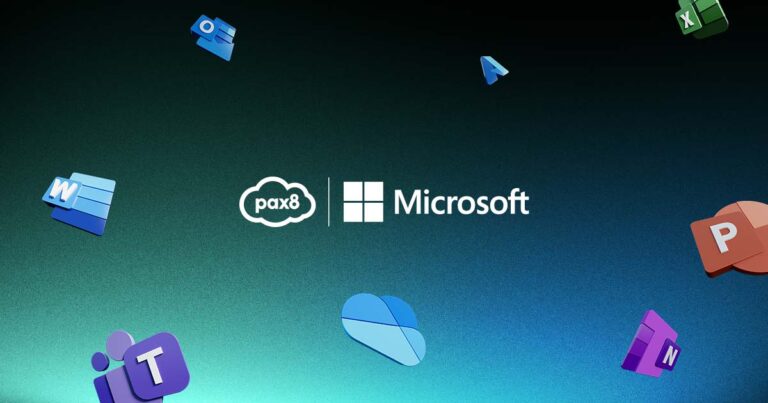Top advice from our team of experts.
Want to move from a break/fix model to managed IT services but aren’t sure where to start? We’ve helped make it happen for countless Pax8 partners – and now we’ve condensed all our top advice into this short recording from Craig Donovan, Senior Vice President of Partner Services at Pax8.
Video Transcript
Hello. This is Craig Donovan, Senior Vice President of Partner Services. We have Pax8 Academy to meet every partner where they are and deliver the content you need right now.
Today, I want to talk to you about transitioning to a managed service model. Changing your business from project-based or break/fix models to a managed services offer has tremendous benefits, but also a number of considerations. The first item is really the why: Why choose managed services? Managed services are actually a completely different model and require a shift in mindset.
In classic break/fix, what’s good for you as the service provider is bad for the client. Something went wrong — a machine isn’t working, a virus has taken hold, some bad situation has hit your client. By nature, this creates a transactional experience where you benefit from a client’s misfortune. On top of that, break/fix tends to be chaotic, with limited control over the kinds of projects you work on, the condition and the environment you inherit — or even what your revenue stream looks like. In contrast, managed services are all about a relationship — not a transaction.
You are now firmly on the same side of the table as your client, both you and your client are working together proactively, motivated by the same goal — keeping things running. You have new metrics, new focuses — things like uptime standards and relationship quality. Not only is this terrific for your client, but it’s incredible for your business as well. Recurring revenue is king.
Now that you transitioned from the hit-or-miss aspect of project work into a predictable, reliable stream of revenue (in fact, 57% of top IT service providers say the desire to shift their company business model to recurring revenue is one of the main reasons for adding cloud-based managed services), one way to optimize your operational technical teams is actually to enforce standards on the technology you support — your tech stack. There are actually infinite ways you could build a stack, but one recommendation is to start with Microsoft.
Every business runs on email and productivity solutions. And increasingly, those solutions are cloud. In fact, surveys of technology buyers indicate that businesses across the board expect to increase cloud and managed services spending in 2021. The opportunity to move to the cloud has never been stronger. You see, periodically there are global conditions that force seismic technical shifts. The COVID-19 pandemic is a classic example of a catalyst for change. We saw more than a decade of cloud transformation happen over the course of few months.
We can actually use Microsoft Teams as one benchmark of this transformation. Microsoft Teams is this terrific collaboration tool that — while always important — became business-critical when COVID forced the world into a remote model. In November of 2019, there were 20 million global seats. By March 2020, just five months later, 32 million seats. That’s an increase of 12 million seats in just five months. And then they added another 12 million the following month. And Microsoft added 31 million more in May. This is a massive opportunity.
The world has shifted remote, and it’s never going back — but even with all these seats that have moved to Microsoft Teams, we’re just scratching the surface. Seventy-six percent of businesses plan on long-term IT changes resulting from COVID. The opportunity is immense, and those shops that embrace the shift to the cloud will not only survive but thrive. Once you’ve taken advantage of the Microsoft opportunity, it’s time to layer in next-level security and disaster recovery tools.
Things like ransomware and phishing attacks, foreign bad actors, and other security threats, they’re not just a problem for big companies but for everyone, including your clients. Be the team that your client trusts to protect what’s most important to their business — their data. Tremendous service for your clients actually starts in your own business. How you manage and run your internal business is arguably more important than even your client-facing activities. It’s imperative that you are automated, secure, and predictable. And good housekeeping starts with a strong internal tool set.
One of the first decisions that most managed service providers make is their PSA and RMM tools. PSA, or professional service automation, tools serve as the backbone of a managed service provider. This is a comprehensive suite of tools designed to handle ticket tracking and management, inventory, client data, even billing tasks like quoting and invoicing.
If you are still running your business off of email and manual spreadsheets, it’s almost a certainty that you are leeching money through mistakes and inefficiency. The RMM, or remote monitoring maintenance, tool is a key component of a proactive well-run shop. These tools allow you to remotely manage end user machines from your office. You can remotely deploy software and updates, audit inventory, remediate many issues before they become a problem, and even troubleshoot reported tickets. And while tools are important, we can’t forget about documentation.
Documentation is actually a key aspect of not only setting expectations with your clients but also ensuring your own protection. There are a number of documents critical to a well-run service provider. The relationship typically starts with a master service agreement. This document defines legal expectations, covers things like payment terms, liability and arbitration, expectations, and waivers. They’re generally designed to legally protect you as the service provider. Now, how are you setting expectations with your clients?
I recommend documenting your service response times, hours of operation, and SLAs in a clear, easy-to-understand service plan. Following that is your statement of work, or SOW. An SOW is used to provide clear expectations around what is covered in your managed service, who is responsible for what parts of the IT business, and a very clear definition of your role. Now that you’ve locked down many of the tactical parts of being a service provider, I think it’s critical to make sure you know the answer to two major questions.
Number one: Who are you?
What is your value, your identity? What is it that you hang your hat on — is it killer client service, maybe top-notch technical abilities, or do you really understand how to connect with a very specific business type, like dentists or restaurants? Do you know clearly what you do — and possibly more importantly, what do you not do? You see, knowing your value allows you to better communicate with prospective clients, as well as intelligently define your price model.
Number two: Who is your target client?
One glaring mistake that many partners make is believing that any client is the right client. It’s hard to serve every possible client well. So, it’s important to really dial that in. What is your target client size? Do you have a specialized vertical? Does their desired tech stack match up to your skillset? Most importantly, are they looking for the kind of relationship that you provide? Take the time to really define the profile of your target client. Not only will this help you find prospects, but then serve them as well.
All in all, the opportunity for MSPs is massive. The managed services industry is expected to be $296 billion globally by 2023. You don’t want to miss out and Pax8 is here to help out with Academy courses and resources, all purpose-built to help you build your business.
Thank you for tuning in today. I look forward to seeing you in class!





